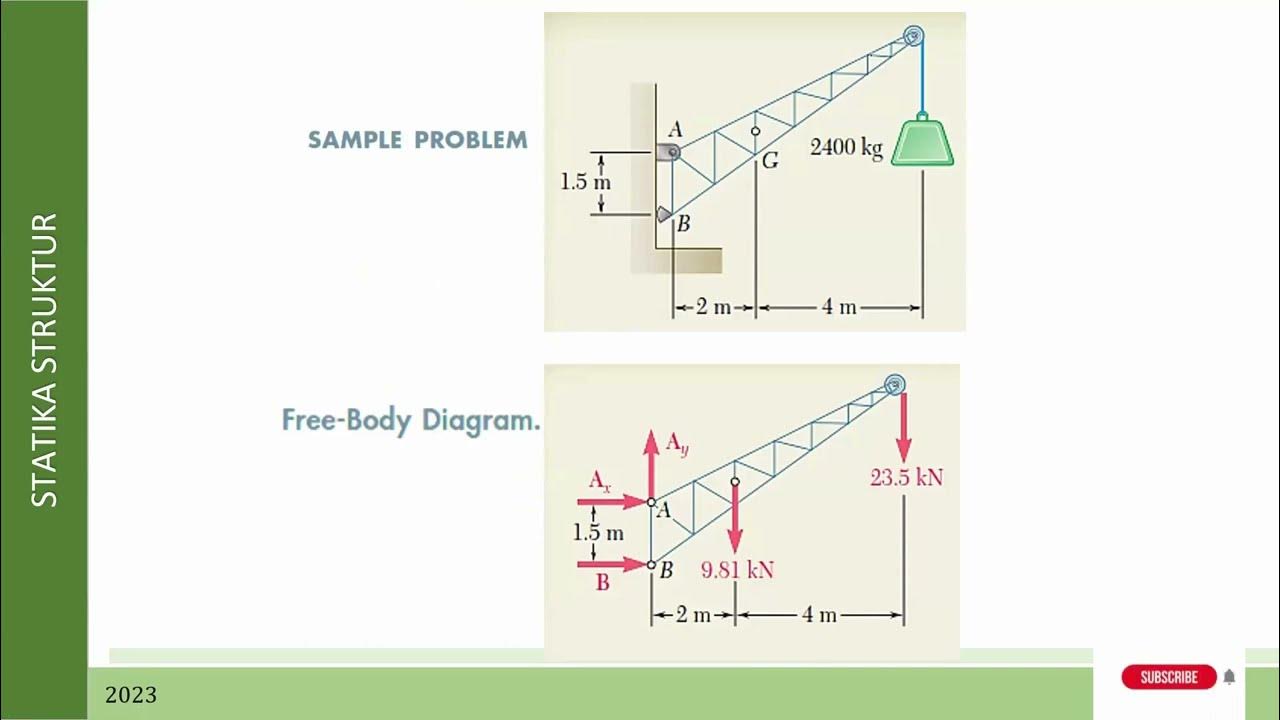Statika Partikel 3D (5/5): Kesetimbangan Partikel dalam Tiga Dimensi
Summary
TLDRThis video script provides a detailed explanation of particle equilibrium in three dimensions, focusing on the analysis of forces acting on a system of particles. The process involves determining the tension forces in cables supporting a 100 kg weight, using a coordinate system (x, y, z) and vector analysis. The script walks through the steps of setting up a free-body diagram, calculating force components in each direction, and solving a system of linear equations to find the tension in the cables. It combines theoretical principles of Newton’s law with practical mathematical techniques to solve for unknown forces in a real-world scenario.
Takeaways
- 😀 Particle equilibrium in three dimensions requires the sum of forces (ΣF) in the x, y, and z directions to equal zero (ΣF_x = 0, ΣF_y = 0, ΣF_z = 0).
- 😀 The lesson builds on previous concepts of Newton's First Law and particle equilibrium in two dimensions.
- 😀 In solving problems, it's important to break down forces into their components along the x, y, and z axes.
- 😀 Forces acting on a particle, like tension from strings and gravitational force, are represented as vectors with components in the three coordinate directions.
- 😀 A free body diagram is essential for visualizing the forces acting on a particle and helps in determining the force components.
- 😀 Tension forces in strings are calculated using the position vectors derived from the coordinates of the points of attachment.
- 😀 The tension forces can be expressed as scalar values multiplied by unit vectors to indicate direction.
- 😀 Solving equilibrium problems often involves a system of linear equations with three variables (one for each coordinate direction).
- 😀 Techniques like elimination and substitution are used to solve the system of equations and find the unknown forces in the system.
- 😀 Vector decomposition is crucial in determining the magnitude and direction of forces acting on a particle.
- 😀 The lesson emphasizes the importance of mastering basic concepts like vector analysis and equilibrium in preparing for more advanced mechanics problems.
Q & A
What is the main topic of the script?
-The main topic of the script is particle equilibrium in three dimensions, focusing on applying Newton's laws to determine forces acting on an object in equilibrium.
What are the components of the equilibrium equation discussed in the script?
-The components of the equilibrium equation discussed are: Sigma F_x = 0, Sigma F_y = 0, and Sigma F_z = 0, where F represents the force components along the x, y, and z axes respectively.
What does the speaker mean by 'free body diagram'?
-A 'free body diagram' is a graphical representation showing all the forces acting on an object, isolating it from its surroundings to analyze the forces and moments in a given problem.
What was the physical setup for the example problem discussed in the script?
-The example problem involves a system where three ropes support a 100 kg weight, with the weight being at a specific point in space. The problem requires determining the tension in each rope.
How is gravity taken into account in the equilibrium analysis?
-Gravity is taken into account by calculating the weight of the object as the force acting downwards. In the script, the weight is determined by multiplying the mass of the object (100 kg) by the gravitational acceleration (9.81 m/s²), resulting in a force of 981 N.
How are the tension forces in the ropes calculated?
-The tension forces in the ropes are calculated by first determining the position vectors of the ropes, then using vector analysis to find the components of the force in the x, y, and z directions. This leads to a system of linear equations that can be solved to find the tensions.
What method is used to solve the system of equations for the tensions in the ropes?
-The system of equations is solved using the method of elimination, where one equation is substituted into others to reduce the system to simpler forms, eventually finding the tension values for each rope.
What is the significance of the 3D coordinate system mentioned in the script?
-The 3D coordinate system is significant because it provides the reference frame for analyzing the forces acting in three dimensions. The x, y, and z axes are used to break down the forces into their components for easier calculation.
What challenges are presented by solving equilibrium problems in three dimensions?
-The challenges include handling the additional complexity of the third axis, requiring more steps to set up and solve the system of equations. Additionally, the increased number of forces and components makes the problem more complex compared to two-dimensional problems.
How does the script summarize the main takeaways from the lesson?
-The main takeaways from the lesson include understanding the use of a 3D coordinate system, calculating position vectors, resolving forces into components, and solving linear systems to determine equilibrium conditions in 3D. It emphasizes the importance of mastering these concepts for real-world applications.
Outlines

هذا القسم متوفر فقط للمشتركين. يرجى الترقية للوصول إلى هذه الميزة.
قم بالترقية الآنMindmap

هذا القسم متوفر فقط للمشتركين. يرجى الترقية للوصول إلى هذه الميزة.
قم بالترقية الآنKeywords

هذا القسم متوفر فقط للمشتركين. يرجى الترقية للوصول إلى هذه الميزة.
قم بالترقية الآنHighlights

هذا القسم متوفر فقط للمشتركين. يرجى الترقية للوصول إلى هذه الميزة.
قم بالترقية الآنTranscripts

هذا القسم متوفر فقط للمشتركين. يرجى الترقية للوصول إلى هذه الميزة.
قم بالترقية الآنتصفح المزيد من مقاطع الفيديو ذات الصلة

ST02: Solution for Exercise Problem 1

Statika Partikel 3D (1/5): Komponen Gaya dalam Tiga Dimensi

Vektor dan Kesetimbangan Gaya

Teori Dasar Struktur Truss: Persamaan/Rumus, Reaksi Tumpuan, Gaya tarik atau tekan (T atau C)

Chemistry - Atomic Structure - EXPLAINED!

O Discreto Charme das Partículas Elementares Parte II - Aula de física - Ensino médio
5.0 / 5 (0 votes)
